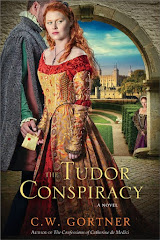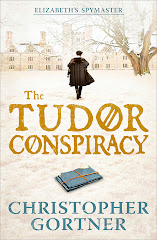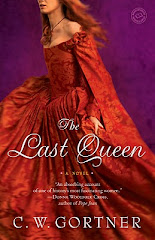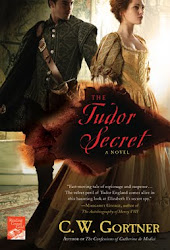Today is the publication day for Margaret George's epic new novel,
ELIZABETH I. Margaret graciously agreed to this interview, and in celebration of her book Historical Boys is offering a signed first edition of ELIZABETH I. See below the interview for entry details. Please join me in welcoming Margaret George again!

HB:
Congratulations on the publication of ELIZABETH I
. It's an honor to have you with us. This is a vivid and compelling novel detailing the later years of Elizabeth I's reign and her long, often tumultuous relationship with Lettice Knollys. Elizabeth I is such an iconic figure, and she exerts endless fascination. What inspired you to write about this portion of her life, as opposed to, say, her younger years?
MG:I identified more with Elizabeth at the height of her power than with the ‘princess in peril’ of her youth. Also, I wanted to explore a time that is strangely neglected by writers---the years following the Armada. In many ways those were the most interesting, and certainly the most “Elizabethan”, since many of the big names come into their own then, such as Shakespeare, Marlowe, Raleigh, Donne, Francis Bacon, and Robert Cecil. At the same time Elizabeth was grappling with her own issues of mortality and what would become of England after her death. This rich period is looked back on as the golden age of England.
HB:
Lettice Knollys is often treated as either the ambitious lady who snagged Robert Dudley from under Elizabeth's unsuspecting nose or as the hapless object of the queen's ruthless jealousy. What interesting facts did you discover about Lettice? How is she different or similar to the myths surrounding her? Why do you think she presents such an intriguing counterfoil to the queen’s voice? MG: Lettice was in many ways Elizabeth’s doppelganger. They shared similar coloring, intelligence, and personality, as well as being cousins. It must have been difficult for Lettice to see someone so like herself be given so much, while she, Lettice, had to fight for everything, and face setback after setback. It was almost a Cain and Abel story. On the other hand, Elizabeth could envy Lettice’s freedom. Just before I started writing, new evidence about Lettice’s age came to light in a family record, revealing Lettice as younger than pr

eviously thought---almost a decade younger than Elizabeth. Also, her time abroad in Basel as a young girl, when her staunch Puritan father had to flee England from “Bloody Mary”, must have stamped her in ways that Elizabeth had never experienced. Lettice knew what it was to be exiled, and to be a foreigner. If that taught her to be grasping, greedy, and calculating, still, I found her a sympathetic character. She reminded me of Scarlett O’Hara, vowing to never be hungry again, and with good reason.
HG:
You are well known for your biographical novels of historical figures, from Henry VIII to Cleopatra to Mary Magdalene. What advantages or disadvantages did you find in terms of researching this particular novel? What decisions and/or compromises did you find yourself making as a writer when it came to telling Elizabeth’s story? MG: Although Elizabeth is a familiar icon, and the nearest to our own time of anyone I’ve written about, she was a great mystery. She has a shell, a public persona that we all know and can see (there are more portraits of her than any other English monarch, but they may not really look like her at all, as she managed her image so carefully), and an inner self that is utterly guarded. We feel that she is hiding a secret of some sort, but we can’t guess what it is. She left no diary, no memoirs (in spite of many novelists writing them for her), very few personal letters. The poetry attributed to her is doubtful, and the anecdotes---usually illustrating her wit---are also of questionable authenticity. So I had to read between the lines and make educated guesses about what went on in her head. Since she didn’t want people to know what she was thinking, this was a challenge. A French ambassador said, “ She is a princess who knows how to transform herself as suits her best.” By limiting myself to one period of her life, I was able to cut down on the number of different facets I had to deal with. In the end I had to construct motivations that seemed the most likely to me, but as with everything connected with Elizabeth, I was taking a leap of faith---in my own ability to decipher her secret code.
HB:
Elizabeth’s relationship with Essex was complex and is often misunderstood. What do you think motivated Essex to act as he did? MG: Essex is a fascinating character but not a mysterious one like Elizabeth. He was a man born out of his time---he belonged in an earlier era when chivalry was in full flower, not in the cynical age he actually lived in. His gestures--- duels to settle matters of honor, his need for extravagant adventure and derring-do, and harking to military glory as a way to power---all point to that. He had outsized charm and much talent, and Elizabeth was drawn to that. She probably thought she could ‘tame’ him as she had his stepfather, Robert Dudley, and make him into a useful courtier. But, besides the Miniver Cheevy-like aspects of his personality, Essex seems to have suffered from a bipolar disorder that made him increasingly cut off from reality. It is dangerous to make a medical diagnosis on a historical character but his behavior---mood swings and grandiosity alternating with collapses and remorseful asceticism, point in that direction. That meant that sooner or later, since he was given huge public responsibilities he could not retire from, he was going to come to doom. Perhaps he just saw no way out and this was his way of ending it.
HB:
Please tell us about methods that you employ to give your characters authenticity.
MG: I start by trying to find out everything about them---an ambitious undertaking! I feel that the more I know of hard facts, the more I will be able to connect the dots for the areas that are more shadowy. You know how they use sonar to make a grid on the ocean floor when looking for objects; that’s what I try to do with the facts. I record each month of a character’s life on

one page of a spiral notebook, and every time I get a firm date for something I write it down, the big and the little alike. So, for May 1936 in Henry VIII’s life, I might write on the 19th: Anne Boleyn executed. On May 26th, I might record, “Henry is measured for a new green cape.” It becomes a sort of live-streaming video of his life. That gives me a feeling that I was really there and I know what happened. (Even if this is most likely not so as there were plenty of things he did in May 1536 that obviously weren’t recorded.)
I also, whenever I can, try to find someone I know, or know of, who may share traits with that character, so I can ‘see’ them in action. Often the historical character is a composite of real people I use for reference. Essex reminded me a bit of Jim Morrison---not that I actually ever met Jim Morrison. Of course Morrison’s personality and behavior was fueled by drugs and alcohol, whereas Essex’s was natural. Both were handsome, young, and self-destructive.
HB:
How do you think this novel speaks to today’s reader or how do the events you evoke resonate for today’s world? MG: I was struck by the similarities between Obama and Elizabeth. “No drama Obama” has an echo in Elizabeth, who was profoundly grounded in Realpolitik and was a cautious, clear-sighted realist. Knowing that a cool head was the best way to survive a crisis, she always kept steady on course. In some ways she seems very modern to us, and the problems she faced are still ones we face. How to maintain command of a situation? What does it take to be a successful world leader? She didn’t sponsor any great building programs, sign any significant laws such as the Magna Carta, or conquer any territory---all the standard things a successful ruler should do. Yet she gave her name to an age. What she gave her people was what everyone still wants, and now demand of their world leaders: stability, peace, and pride in themselves and their country.
HB:
If you can, please tell us about your next project.
MG: I’d like to do a novel about the conflict between Boudica, the warrior queen of Britain, and the emperor Nero, her ultimate adversary. With her enormous ‘people’s army’ and wheeled chariots, Boudica took the occupying Romans by surprise and destroyed Colchester, St Albans, and London itself. This all happened during the time in Nero’s rule when he had just finished getting rid of his bothersome mother and was turning into the Nero of legend. What outsized personalities, and what an interesting corner of history! I will probably do it as alternating first person accounts.
To enter to win a copy of ELIZABETH I
, please leave a comment below telling us which of Margaret's previous novels is your favorite. You must be a follower of this blog; unfortunately, this contest is open to US residents only due to publisher territory restrictions. Contest ends on April 15..





























